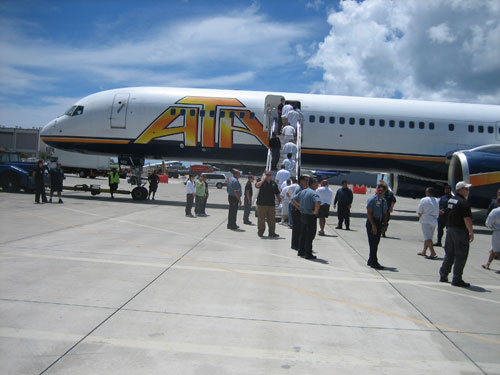Captive audience

Because of overcrowded prisons, the state sends prisoners to facilities on the mainland. Here, Hawaii inmates bound for prisons in Arizona and Kentucky board an ATA Boeing 757.
Charter flights usually carry vacationers or sports teams.
But about four times a year, the flights are different.
That’s when up to 150 male inmates with hand and leg restraints are loaded onto a convoy of buses and transported under armed guard from prison to the airport.
There’s no waiting at the ticket counter. No removing shoes to go through security. No handing a boarding pass to the gate attendant.
These felons, convicted of crimes ranging from murder to drug possession to sexual offenses, are driven directly onto the tarmac where they board a plane for a six-hour flight between Honolulu and Phoenix.
"Con Air," anyone?
Don't miss out on what's happening!
Stay in touch with breaking news, as it happens, conveniently in your email inbox. It's FREE!
In 1997, Nicolas Cage starred in that aptly titled movie about a newly released ex-con and former U.S. ranger who finds himself trapped in a prisoner transport plane when the passengers seize control.
Now step aboard for Hawaii’s version of "Con Air."
Everybody flies coach; no one earns frequent-flier miles.
There are movies on board, but nothing more explicit than "PG," with violence and sexual themes verboten.
And forget about dining utensils — even the plastic variety. Everyone is served food they can eat with their hands, such as sandwiches, fruit and snacks.
If nature calls, inmates are restrained and escorted to the bathroom, then hand restraints are taken off so they can do their business.
For safety reasons there are about 15 security personnel on the plane. Inmates are strategically seated to avoid friction between groups or to separate those in protective custody.
A nurse is also on board at all times in case medical attention is needed.
But if you’re wondering about the potential for a prisoner revolt at 30,000 feet, think again.
It just doesn’t happen like in the movies, says a Hawaii state official and the executives of the companies responsible for transporting the inmates.
"Knock on wood," says Curtiss Sullivan, managing director of operations for Nashville, Tenn.-based TransCor America, one of the two companies that transport Hawaii prisoners.
"Con Air" "is obviously the Hollywood version of a mass prisoner movement," he said. "When you go watch the movie and you look onboard the aircraft (in the movie), it’s almost like a flying prison. Ours is not designed that way. Ours is chartered through several independent carriers throughout the U.S. that offer service to move inmates.
"They look very similar to a commercial aircraft, but you’re just not going to have someone wheeling a cart down the center of the aisle, asking if you want the different types of amenities that come with flying."
Hawaii’s Department of Corrections for Public Safety is in the flying business because the state doesn’t have enough room in its prisons for all of its inmates. There are nearly 2,000 men in two prisons in Eloy, Ariz. — the Red Rock Correctional Center and Saguaro Correctional Center — that are roughly 45 minutes from Phoenix.
Beside the cost for housing the inmates, flying them across the Pacific Ocean is quite expensive, about $180,000 to $225,000 for each round trip, depending on fuel costs and other factors, said Tommy Johnson, deputy director of the Corrections Division for the Hawaii Department of Public Safety.
"Each time we do a transport, we look at those inmates newly coming into the system who have longer sentences that we don’t have the room to house, and at the same time we look at inmates currently housed on the mainland near the end of their sentences or who are ready to transition to work-furlough programs or a sex offender treatment program, and then we bring those inmates home," Johnson said.
Hawaii also used to send female inmates to Otter Creek Correctional Center in Wheelwright, Ky., but that contract was not renewed last year after some staff misconduct incidents at that prison. The 168 women housed there were returned to Hawaii.
So now only male inmates fly between Hawaii and the mainland. They are flown on either a Boeing 737-700 or Boeing 757 with either TransCor America or Nashville-based PTS (Prisoner Transportation Services) of America overseeing the move. Among the carriers used are Miami Air, Rockford, Ill.-based Ryan International Airlines, St. Paul, Minn.-based Sun Country Airlines and, before it shut down in 2008, ATA Airlines.
"This is no different than loading tourists on a plane to go to Hawaii," said Thor Catalogne, owner of PTS. "Most of the inmates coming over to Hawaii are coming back for parole or to get a Hawaii work release, so they’re more than happy they’re coming over. … A lot of the guys (going to Phoenix) have never been on a plane and have never gotten off the island. Just the plane ride is a new experience."



